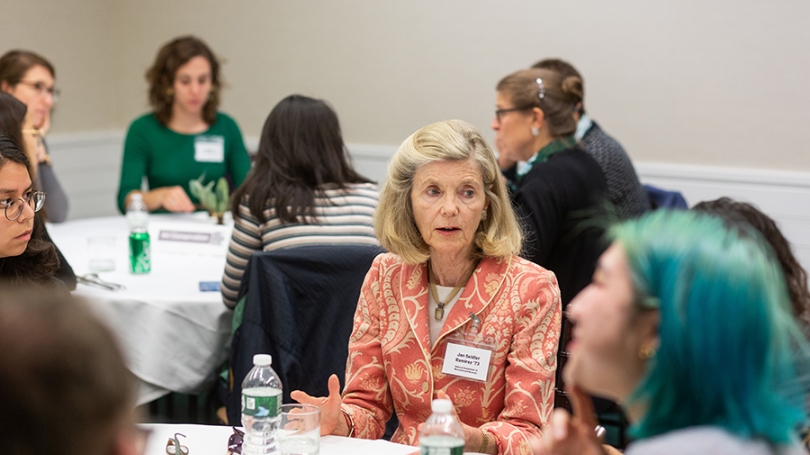Jan Seidler Ramirez '73, the Founding Chief Curator and Executive Vice President of Collections at the National September 11 Memorial and Museum, recently participated in the Hood's "The New Now: Art, Museums, and the Future" symposium. Hosted in celebration of Dartmouth's 250th anniversary and the reopening of the Hood, the symposium showcased alumni who have gone on to careers in museums through panel sessions and a reception. Learn more about Jan's career below.
What have you been up to since you graduated from Dartmouth?
Except for a graduate school layover and time spent writing my dissertation (which often felt interminable), I've worked continuously in the museum field, mainly in the curatorial arena. That constancy may not seem very adventurous. But like the proverbial duck, I discovered the ideal pond for my career interests early on, never leaving this habitat, except for once. Briefly, I hung out a shingle as an independent consultant. Although the diversity of clients and projects kept me on my toes, I missed having colleagues; I missed the familiarity of museum policies and practices; and I missed having access to the idea bank represented in an institutional collection. I folded my freelancer's tent after a year's experiment and gratefully returned to the museum as my employment homeport.
Were your original intentions to pursue a career in the arts after college?
I was a poster child for the Liberal Arts Education, wandering around the humanities curriculum but mostly gravitating to courses in American literature, history and art history. Coming from a family with its share of academics, I assumed that I'd follow suit and aim for a college teaching position. But my graduate school years happened to coincide with three influences that re-mapped my direction: the emergence of material culture studies an avenue for historical research; the deepening investment of the National Endowment for the Humanities in museum-based exhibitions as a legitimate format for disseminating scholarship (with the public-at-large as the intended learners); and a truly transformative internship– then called a "practicum semester"–in the American Decorative Arts & Sculpture department of the MFA Boston, during the high tide of the national Bicentennial. The wedding to a museum career followed thereafter.
Was the Hood a valuable resource for you as an undergraduate?
I date from the Paleolithic era before the Hood existed as a convening center for visual arts study on campus. I recall my art history classes as somewhat cardiovascular undertakings–dashing through Carpenter Hall to study limited work from the college collection on view there; sprinting to the Library, various Parkhurst Hall offices and the Hop to track down other art-worthy samplings; extra laps outside to analyze burial stone designs in the Dartmouth cemetery; the occasional field trip to Saint-Gaudens' studio in Cornish, NH. If your luck held, an invitation might arrive to see the wall offerings in the President's House or in the private collections of certain faculty members. Needless to say, I was thrilled for the Dartmouth community when the Hood arrived, and have been awed by the speed of its professional success, permanent collection growth, and pivotal impact on students who take advantage of its many resources–including the Hood's stellar staff.
What do you enjoy most about working in the arts?
Working in the arts has been a life-long learning experience, so there is great pleasure and surprise in what lightbulbs might be illuminated or ideas generated during a museum workday. These come from all kinds of sources–research, colleagues, donors, a breaking news cycle, a fortuitous comment or question from a visitor, observing something afresh or something altogether novel–in your own visual travels or on view at another museum. Museums are also havens for story-tellers and commentators who use objects and artwork as their vocabulary. When I started in this field, the museum professional was perceived as the "authority" invested with these narrative powers. But that scholarly voice has changed markedly over the years, in response to visitors and community users (or should-be museum users) being invited into the dialogue. Their perspectives and contemporary concerns have mixed things up for the better, obliging museums to revisit the assumption of public trust at the core of their missions, and to re-engineer themselves as more engaged, transparent and useful civic and cultural partners. This interrogation is continually challenging. But the process is also both essential and dynamic and therefore energizing. No one wants to work in a fossil itself.
About Jan
Jan Seidler Ramirez '73 is the Founding Chief Curator and Executive Vice President of Collections at the National September 11 Memorial and Museum in New York City. Under her guidance, the Memorial and Museum's collection has grown to include many thousands of objects, artworks, photographs, films, oral histories and audio artifacts, architectural relics, and other primary evidence materials relevant to 9/11 and its legacy. In creating this resource, which continues to grow, she and her staff have worked directly with stakeholders from the multiple communities and agencies directly affected by 9/11, and with artists, photographers, and filmmakers who responded to these transformative events. Previously, Jan served as vice president and museum director at the New-York Historical Society, where she played a major role in developing that institution's 20th-century collecting program and its History Responds initiative, a series of exhibitions, public programs, and collection acquisition efforts focused on the 9/11 attacks in their broad historical context. In her career, Ramirez has held curatorial, interpretation, collections development, and senior administrative posts at museums in Boston and New York, including the Boston Museum of Fine Arts, the Hudson River Museum, and the Museum of the City of New York. She has taught and lectured extensively on American history, arts, material culture, and the phenomenon of "crisis collecting" and authored numerous publications and essays relating to American arts and cultural history. A graduate of Dartmouth College, where she majored in English, she earned her PhD in American studies at Boston University.
